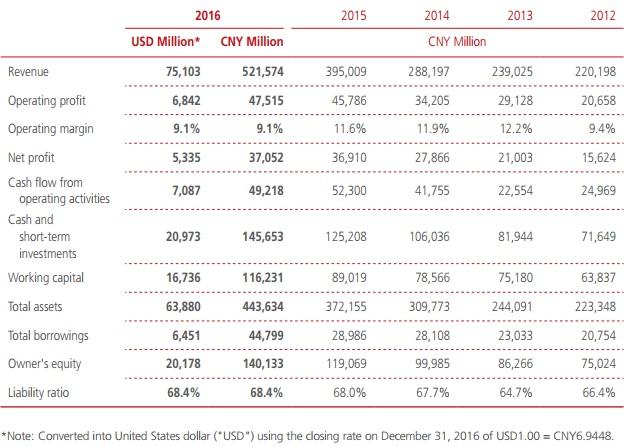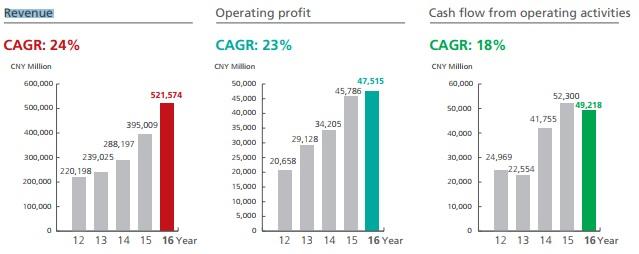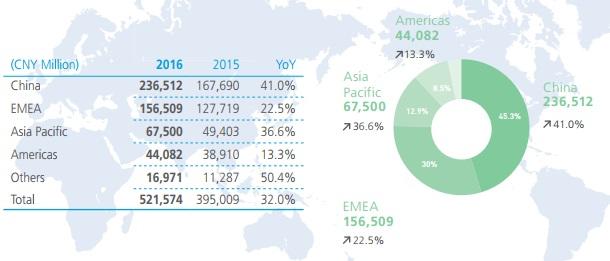Executive Summary
The report revolves around Huawei Technologies Co. Ltd. and the primary peculiarities of its functioning. Today, it is one of the most fast-growing companies that function in the sphere of telecommunications. The report provides the in-depth investigation of its financial performance, organizational structure, perspectives, integral strategy, marketing approach, its logistics, and resources.
The given aspects are analyzed regarding Huwaeis theoretical entry to a developing nations environment. Under these conditions, significant attention is devoted to the investigating its functioning and possibility of setting up its operations in a particular country. The analysis evidences that the company demonstrates stable showings and continues its evolution. There is a solid basis for its further development. Moreover, it looks for new outlets and international partners. For this reason, Huawei could be recommended as an appropriate foreign company to cooperate and promote the further development of a country.
Introduction
Today we could observe the rise of numerous countries which are very often called as developing nations. The fact is that the critical events of the second half of the 20th century like the WWII and the Cold War provided different states with numerous opportunities to reconsider their role in the international discourse and start participating in processes that shape the global economy (Hill & McKaig, 2014).
Under these conditions, nations like Thailand, Bangladesh, China, etc. demonstrated stable economic growth and overwhelming speed of their development (Hill & McKaig, 2014). These processes became crucial for the modern world as today we could observe results of alterations mentioned above. Developing nations attract numerous international companies because of the perspectives they might provide to organizations and potentially high level of income. For this reason, the choice of a potential partner among foreign firms becomes a complicated issue.
Background
Choosing a company, several factors should be taken into account. First, it should have a particular experience of international cooperation to align an efficient partnership. Second, the company should demonstrate stability and perspectives for the further evolution. Third, it should be able to function regarding the unique conditions of the developing nations like unskilled workforce, the need for the creation of the industrial base, etc. In this regard, Huawei Technologies Co. Ltd is chosen for the investigation as a potential partner. It meets the above-mentioned requirements and provides numerous opportunities for the research. That is why the report is devoted to the in-depth analysis of Huawei and its perspectives regarding the theoretical entry to a developing country.
Company Description
Huawei is a Chinese international company which functions in the sphere of networking and telecommunications equipment and services (Huawei, 2016b). It is headquartered in Shenzhen Guandong. The company was founded in 1987 by Ren Zhengfei as a small unit focused on manufacturing phone switches (“Corporate information,” n.d.). However, with its further evolution, Huawei started to manufacture more complex equipment including telecommunications networks.
It also provided operational and consulting services to organizations globally (Huawei, 2016b). Due to the efficient development strategy and enhanced quality of the suggested goods the company managed to enter the phase of its rapid evolution. At the moment, Huawei is the most significant telecommunications equipment manufacturer in the world, and it continues to evolve(Huawei, 2016b). Moreover, it is the worlds number three smartphone brand which competes with Apple and tries to win the rivalry by adhering to a unique strategy (Shepard, 2016).
The company possesses 8.3 percent of market share (Shepard, 2016). Moreover, in accordance with specialists forecasts, the level of sales in Europe will continue to grow which will create the basis for Huaweis further evolution (Huawei, 2016b). It sells about 108 millions of phones per year and approaches its central rivals Samsung and Apple by closing the gap and ramping up production (“Corporate information,” n.d.).
The company has its offices in countries that are traditionally considered essential outlets and aligns cooperation with the USA and Europe. Furthermore, regarding Huaweis desire to become the leader in the sphere of telecommunications and services, numerous attempts to cooperate with strategic regions could be noted. It has operations across the world in Europe, Russia, Middle Eastern Region, USA, Canada, India, etc. These facts evidence the companys stable position and perspectives for the further evolution.
Drastic changes in the structure of Huawei and its size stipulated significant alterations in the workforce, its composition, and number. The company has about 180000 employees in different countries (Huawei, 2016b). At the same time, the rapid evolution of technologies and significant rivalry introduce the need for research in the sphere of digital technologies. For this reason, Huawei invests about $6 billion in investigations annually (Huawei, 2016b).
Around 80,000 of employees participate in numerous research programs aimed at the improvement of products and search for innovative solutions (Huawei, 2016b). Moreover, the company has 21 institutes in China, USA, Canada, Russia, India, etc. They create a robust scientific base needed to guarantee the preservation of leading positions. In general, research and constant search for new solutions are two essential elements that help to acquire the competitive advantage and
In general, leading Huaweis indicators could be considered positive (see Figure 1). In 2016 the companys revenue comprised $75,103 million which is 32% higher than in 2015 (Huawei, n.d.). Operating profit also increased significantly and is about $6.842 million (see Figure 2). Other vital indicators could be considered appropriate. The net profit is $5,335 million and continues to grow (Huawei, 2016b).
Therefore, the cash flow decreases and comprises about $7, 07 million (Huawei, n.d.). In general, the given showings indicate the stable and gradual development of the company. Income from the carrier business comprises the bigger part of the revenue and is 55,7 %, while consumer business and enterprise business comprise 34,5% and 7.8% correspondingly (see Figure 3). China remains the most important outlet as it guarantees 45,3% of all sales (see Figure 4). Then goes EMEA with 30%, Asia and Pacific region with 12,9% and both Americas with about 8,5% of all sales (Huawei, 2016b). However, all regions demonstrate the stable growth of interest to Huaweis products.
In such a way, regarding the numbers mentioned above, specialists admit positive tendencies in the companys further development. For instance, according to Forbes, Huawei should be considered a new leader in the sphere of telecommunications that will apparently become the worlds number one smartphone brand because of its focus on a particular target audience and its incredibly effective marketing strategy (Shepard, 2016).
Additionally, the brand also engages in a high-profile cooperation with innovative science labs to develop new products and features. Considering a certain lack of ideas peculiar to the leading rivals, Huawei could count on the further improvement of its positions and a gradual rise in income (Shepard, 2016). The shift of the development paradigm and business models evidently has a positive impact on Huawei and promoted its blistering rise (“The company that spooked the world,” 2012). Nowadays, it could be considered an attractive investor and partner which could contribute to the evolution of the economy by opening new factories and creating works for people in the area.
Companys International Strategy
Huaweis latest successes could be explained by its effective development strategy and its operating at the international level. The company cultivates beneficial cooperation with countries that traditionally demonstrate the high level of demand for high technologies and devices produced by Huawei. For instance, in accordance with its annual report, sales in the USA increased in 13,3% if to compare with 2015 (see Figure 4). It means that the brand promotes its spread to areas where its positions were weak.
Europe is also taken as an important strategic region, and the company looks for new ways to align cooperation there. Huawei also fosters international cooperation by joining in various international projects like cloud computing, software-defined networking, or 5G.
Cooperating with other companies, it cultivates ongoing industry development (Huawei, 2016b). Moreover, its international strategy includes attempts to foster cooperation with developing nations that might provide numerous opportunities for the further rise. Huawei increases the number of produced phones every year which means that new plants are needed to support growing demand. Under these conditions, it could become an essential investor to support the development of the industry in a particular state by placing its facilities there and creating new works.
Companys Marketing Approach
In general, Huawei uses simple but effective marketing strategy. It fills the niche of cheap and available smartphones. The fact is that its closest rivals Apple and Samsung manufacture high-quality and reliable devices which also serve as indicators of peoples status. However, drastic alterations in peoples mentalities preconditioned by the rise of technologies altered the role of phones and shifted priorities from exclusiveness to availability (Hill & McKaig, 2014).
Huawei was among the first to note this change and start producing cheap but functional phones for a common customer to be able to buy it. The tendency towards the growth of the middle class stipulated the companys overall success and its stable income. Therefore, Huaweis marketing approach includes close cooperation with developing states to provide them with telecommunication services and products that might be needed. At the same time, these areas support the companys rise and its further spread in strategic areas. The company is also an active member of about 360 standards organizations and industry alliances which are used to create the basis for the further development.
Companys Logistics Approach
The global character of the company introduces a significant need for an efficient supply chain and logistics to guarantee fast delivery of needed goods and components to different areas where the company functions. For this reason, Huawei established its own unique system for tracing basic components of the supply chain (Huawei, 2016b). To ensure that all products are delivered and provide enhanced security measures, the company uses version control, traceability, and reverse logistics.
It means that all unwanted goods, equipment, corrupted phones, or other products go back to the companys facilities through the logistics chain where they could be reused or recycled. The given logistics approach is an essential element of the companys sustainability. The rise of green movements results in the increased necessity to reuse products and avoid harm to the environment and pollution. For this reason, Huawei uses this approach to deliver its goods as the most efficient way to avoid future problems.
Companys HRM
As stated above, the company correctly realizes an outstanding importance of human resources and invest in employee’s education and training. Therefore, there is a Human Resources Committee (HRC) that is responsible for the majority of activities related to the given sphere. It manages and optimizes such elements as the organization, talent, incentives, culture, and cooperation (Huawei, 2016a).
At the same time, HRC ensures that fundamental policies and transformation incentives will be implemented in the functioning of the company to improve HR management and create a comfortable working environment (Huawei, 2016a). The company also invest in the required tools and equipment to enhance performance and attain improved results. For instance, about 12,000 Huawei delivery engineers took part in EHS-related online training and exams to acquire new competencies and promote the companys further growth (Huawei, 2016b). Additionally, the majority of employees can use Huaweis services to cultivate their professional and personal development. In general, the company introduces an innovative approach to HR to educate workers and avoid mistakes in their work.
Analysis
Analyzing all facts mentioned above, several facts should be noted. First, Huawei is one of the most fast-growing companies in the sphere of telecommunications. It means that the brand has good perspectives related to its further growth. Second, the brand operates at the international level and constantly looks for new partners and areas which could be used as outlets. Third, it combines innovations with training when introducing particular approaches to HR. It helps workers to acquire new skills and knowledge related to the sphere. Finally, Huawei supports its sustainability by introducing specific ways to reuse products and adhering to reverse logistics. All these factors demonstrate a significant potential of the brand and its ability to preserve leading positions for a long period.
Recommendation
In general, the company could be recommended as an appropriate foreign investor which can cultivate the rise of the economy in a developing country. Huawei provides training to its workers, and it is fundamental for the would be cooperation as the majority of developing nations is characterized by semiskilled workers. However, they will be provided with an opportunity to learn and enhance their performance.
Moreover, Huaweis focus on the international cooperation is another factor that could be used to justify cooperation. The company looks for new areas where facilities could be placed. In this regard, cooperation with the developing nation will help it to stipulate the further rise. Additionally, its sustainability and stable financial indicators prove Huaweis powerful position. For this reason, it is possible to recommend Huawei as a partner for a long-term cooperation.
Conclusion
Altogether, Huawei is one of the leaders in the sphere of telecommunications. It combines the efficient marketing approach with development strategy focused on the international cooperation. Therefore, the company is expected to become a leader in the sphere of telecommunications if it manages to preserve its competitive advantage. For this reason, cooperation with developing nations becomes a unique opportunity to cultivate the companys further growth and increase the number of sales along with revenues.
The country could also benefit from this partnership because of the creation of numerous working places and development of its infrastructure. Under these conditions, positive recommendations related to the establishment of close economic relations should be given.
References
Corporate information. (n.d.). Web.
Hill, C., & McKaig, T.( 2014). Global business today. Whitby, Canada: McGraw-Hill Ryerson Ltd.
Huawei. (n.d.). Five-year financial highlights. Web.
Huawei. (2016a). Connecting the future. 2016 sustainability report. Web.
Huawei. (2016b). Huawei Investment & Holding Co., Ltd. 2016 annual report. Web.
Shepard, W. (2016). China’s Huawei ‘growing up’ to cecome the world’s no. 1 smartphone brand. Forbes. Web.
The company that spooked the world. (2012). The Economist. Web.
Appendix



